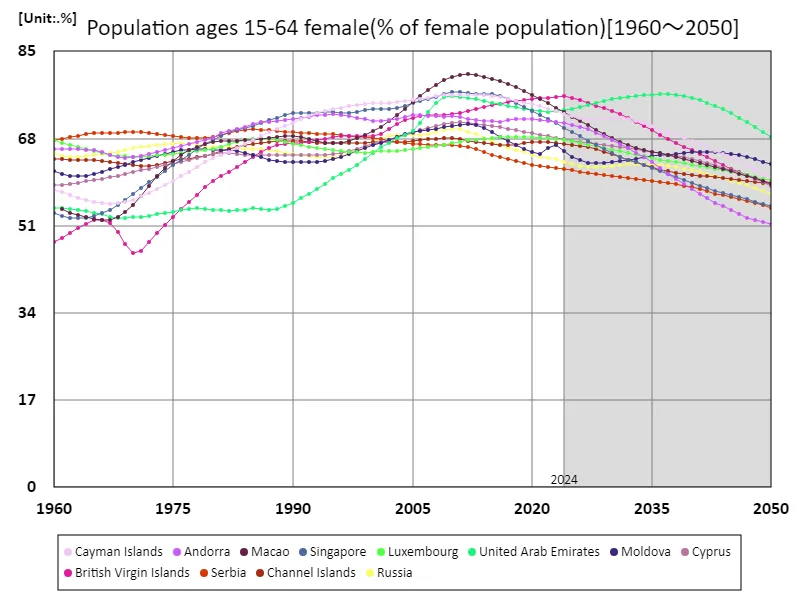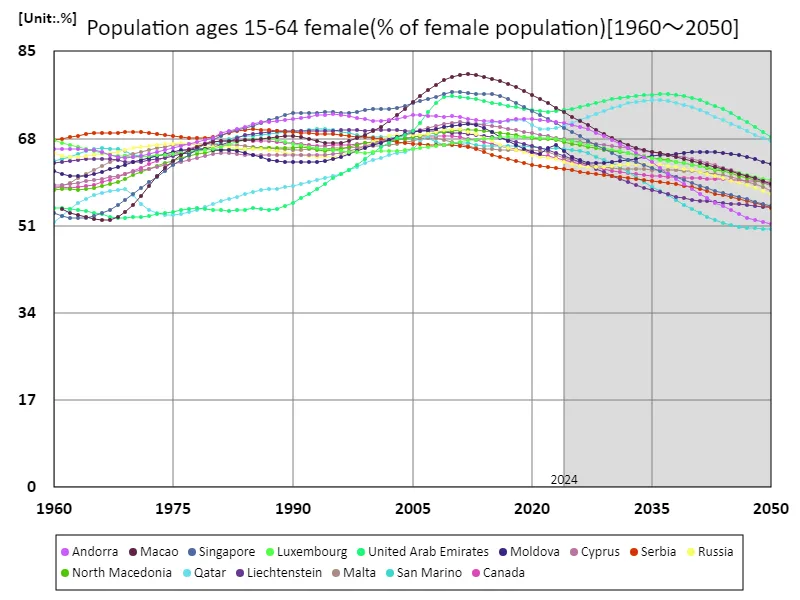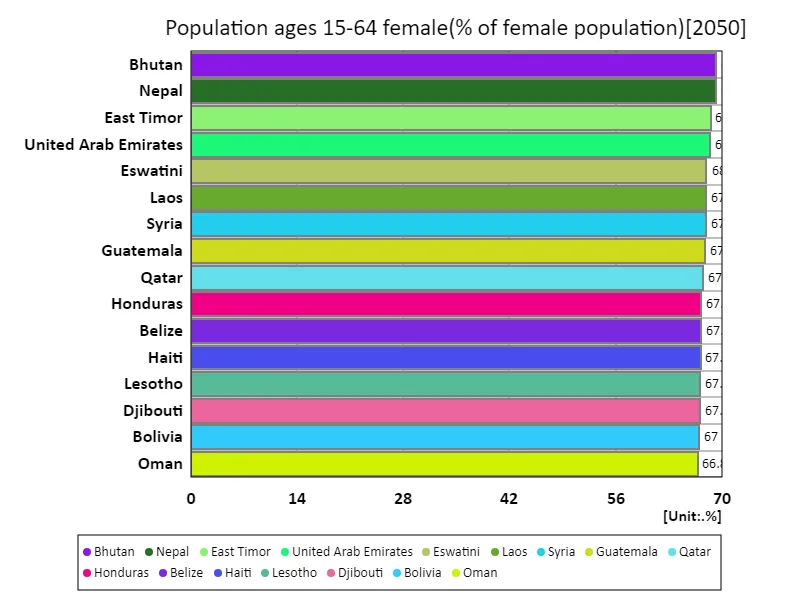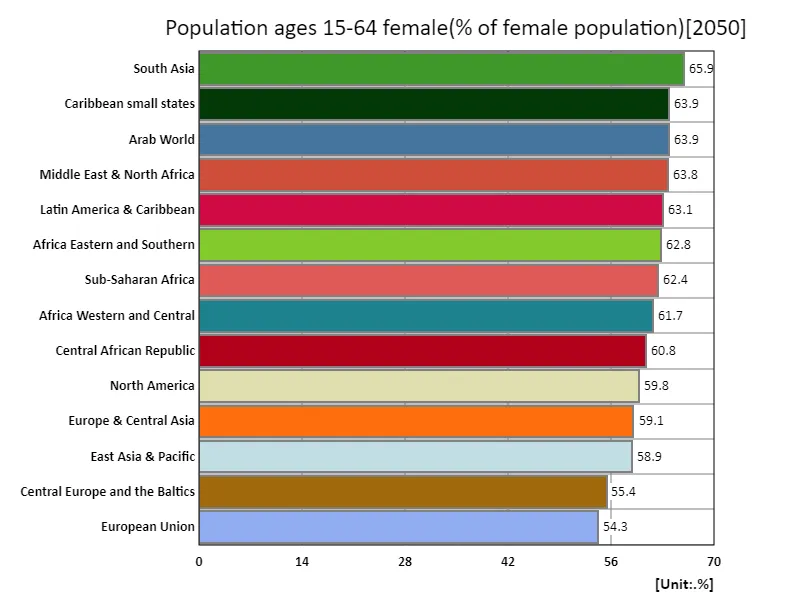Abstract
The data, which shows that the proportion of women aged 15-64 will be the largest in the UAE in 2050, highlights several important trends and characteristics. First, this indicator reflects women’s role in economic activity and their participation in the labor market. The UAE has experienced rapid economic growth over the past few decades and has adopted policies to increase women’s participation in the labor market. As a result, the female labor force supply is increasing and the female population ratio is also high. This phenomenon also indicates that as economies become more diversified and internationalized, women are increasingly being recognized as important economic resources. The UAE in particular is aiming to move away from its dependence on oil and develop in various sectors such as finance, tourism and technology, and women’s participation in the workforce is contributing to that growth. However, this trend is more pronounced than in other regions, placing greater emphasis on women’s economic role in fast-growing countries such as the UAE. Therefore, it is important that future economic growth strategies take into account the utilization of the female workforce and its sustainable development.
Women aged 15-64 (female population ratio)
Looking at the data on the female population ratio between 15 and 64 years of age from 1960 to 2050, Macau’s high ratio of 80.6% in 2012 indicates several important economic and social backgrounds. Macau has experienced rapid growth over the years, with tourism and gambling in particular becoming central to its economy, which in turn expanded its labor market. This economic growth is likely to have encouraged female labor force participation and increased the proportion of women aged 15 to 64 in the population. However, more recent data shows this rate has fallen to 73.3%. This decline can be attributed to several factors. First, as Macau’s economy matures, labor market growth may be slowing. Secondly, the ageing population may be a factor. In particular, as the population ages, the proportion of young people in the labor market is decreasing, resulting in a decline in the female population ratio between 15 and 64 years old. Similar trends can be seen in other regions and countries experiencing economic growth, demonstrating that changes in the labor market and social structure have a direct impact on the female population ratio. Macau offers an important case study for understanding labor force dynamics in an ageing society.


The maximum is 80.6%[2012] of Macao, and the current value is about 73.3%
Women aged 15-64 (female population ratio) (Worldwide)
Looking at the data on the female population ratio between 15 and 64 years old from 1960 to 2050, Macau’s high ratio of 80.6% in 2012 was due to its rapid economic growth and expanding labor market. Macau’s economic growth is mainly attributable to the development of tourism and the casino industry, which has encouraged and increased female participation in the labor market. However, that figure has now fallen to 73.3%. This decline is due to several factors. First, as society ages, the working-age population is shrinking. Also, as the economy matures, growth rates have slowed and female labor force participation is no longer growing as rapidly as it once did. This fluctuation is a common phenomenon in many economies around the world. The case of Macau offers important insights into the impact of population aging and structural changes in the economy on the labor market. Changes in the female population ratio reflect the stage of economic growth and changes in social structure, and therefore require a review of policy planning and economic strategies.


The maximum is 80.6%[2012] of Macao, and the current value is about 73.3%
Women aged 15–64 years (female population ratio) (Worldwide, latest year)
According to data for 2050, Bhutan will have the highest female population ratio between 15 and 64 years old at 69.3%. The figures suggest that Bhutan is actively promoting labour market participation, especially for women. In recent years, Bhutan has aimed to achieve economic development by promoting the spread of education and encouraging women to participate in the labor market, and as a result has achieved a relatively high female labor force ratio. This figure is thought to reflect the fact that national policies are moving towards increasing employment opportunities for women. Meanwhile, the global average female population ratio in 2050 is expected to be 61.3%, with Bhutan’s figure significantly higher than this average, indicating that female labor force participation is not uniform around the world. As the averages show, many countries still have limited female participation in the labor market or unequal economic opportunities. In particular, in regions where the population is aging, the female labor supply tends to decrease. The total figure of 12.1k% is probably an aggregate figure based on data from several countries and depends on the situation in each individual country, so it represents an overall trend. Overall, the report shows that while some countries have high female labor force participation, many still have room for improvement, demonstrating the significant impact of regional economic growth and social policies.


The maximum is 69.3% of Bhutan, the average is 61.3%, and the total is 12k%
Women aged 15–64 years (female population ratio) (region, latest year)
According to 2050 data, the region with the highest female population share between 15 and 64 years old will be South Asia, at 65.9%. This high ratio reflects the fact that South Asia is experiencing rapid economic growth and expanding labor markets. Particularly in South Asia, urbanization and industrialization are leading to improved female education and labor market participation. This is likely to have led to an increase in the female labor supply, resulting in a high ratio. Meanwhile, the global average of 60.6% shows regional variations. While South Asia ranks above average, other regions show varying levels of female labor force participation, influenced by economic conditions, social policies and cultural factors. In particular, in areas where the population is aging, the proportion of women aged 15 to 64 tends to decrease. This is because in an ageing society, the working-age population decreases and female participation in the labor market declines relatively. The total figure of 909% represents the proportion of the global female population aged 15-64 and is calculated by aggregating data from each country. This total reflects variations across regions and indicates the impact of local economic conditions and social policies. Overall, we find that there are large regional differences in female labor market participation, with the effects of aging and the degree of economic development being important factors.


The maximum is 65.9% of South Asia, the average is 60.6%, and the total is 909%



Comments